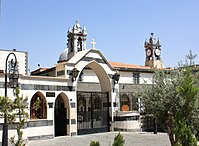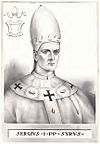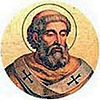
The Syriac Orthodox Church, also known as West Syriac Church or West Syrian Church, officially known as the Syriac Orthodox Patriarchate of Antioch and All the East, and informally as the Jacobite Church, is an Oriental Orthodox church that branched from the Church of Antioch. The bishop of Antioch, known as the patriarch, heads the church and possesses apostolic succession through Saint Peter, according to sacred tradition. The church upholds Miaphysite doctrine in Christology, and employs the Liturgy of Saint James, associated with James the Just. Classical Syriac is the official and liturgical language of the church.
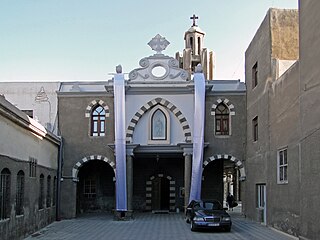
The Syriac Catholic Church is an Eastern Catholic Christian jurisdiction originating in the Levant that uses the West Syriac Rite liturgy and has many practices and rites in common with the Syriac Orthodox Church. Being one of the twenty-three Eastern Catholic Churches, the Syriac Catholic Church is a self-governed sui iuris particular church, while it is in full communion with the Holy See and with the entirety of the Roman Catholic Church.
The Patriarch of Antioch is a traditional title held by the bishop of Antioch. As the traditional "overseer" of the first gentile Christian community, the position has been of prime importance in Pauline Christianity from its earliest period. This diocese is one of the few for which the names of its bishops from the apostolic beginnings have been preserved. Today five churches use the title of patriarch of Antioch: one Eastern Orthodox ; one Oriental Orthodox ; and three Eastern Catholic.

The Greek Orthodox Patriarchate of Antioch, also known as the Antiochian Orthodox Church and legally as the RūmOrthodox Patriarchate of Antioch and All the East, is an autocephalous Greek Orthodox church within the wider communion of Eastern Orthodox Christianity that originates from the historical Church of Antioch. Headed by the Greek Orthodox patriarch of Antioch, it considers itself the successor to the Christian community founded in Antioch by the Apostles Peter and Paul. It is one of the largest Christian denominations of the Middle East, alongside the Copts of Egypt and the Maronites of Lebanon.

Arab Christians are ethnic Arabs, Arab nationals, or Arabic speakers, who follow Christianity. The number of Arab Christians who live in the Middle East was estimated in 2012 to be between 10 and 15 million. Arab Christian communities can be found throughout the Arab world, but are concentrated in the Eastern Mediterranean region of the Levant and Egypt, with smaller communities present throughout the Arabian Peninsula and North Africa.

The Melkite Greek Catholic Church, or Melkite Byzantine Catholic Church, is an Eastern Catholic church in full communion with the Holy See as part of the worldwide Catholic Church. Its chief pastor is Patriarch Youssef Absi, headquartered at the Cathedral of Our Lady of the Dormition in Damascus, Syria. The Melkites, who are Byzantine Rite Catholics, trace their history to the early Christians of Antioch, formerly part of Syria and now in Turkey, of the 1st century AD, where Christianity was introduced by Saint Peter.

The term Melkite, also written Melchite, refers to various Eastern Christian churches of the Byzantine Rite and their members originating in West Asia. The term comes from the common Central Semitic root m-l-k, meaning "royal", referring to the loyalty to the Byzantine emperor. The term acquired religious connotations as denominational designation for those Christians who accepted imperial religious policies, based on Christological resolutions of the Council of Chalcedon (451).

Alphabetical list of Eastern Christianity-related articles on English Wikipedia

The Catholic Church in Syria is part of the worldwide Catholic Church under the spiritual leadership of the Pope in Rome.

Christianity has a long and continuous history in Lebanon. Biblical scriptures show that Peter and Paul evangelized the Phoenicians, leading to the dawn of the ancient Patriarchate of Antioch. As such, Christianity in Lebanon is as old as Christian faith itself. Christianity spread slowly in Lebanon due to pagans who resisted conversion, but it ultimately spread throughout the country. Even after centuries of living under Muslim Empires, Christianity remains the dominant faith of the Mount Lebanon region and has substantial communities elsewhere.

Christianity in Kuwait is a minority religion.

Terms for Syriac Christians are endonymic (native) and exonymic (foreign) terms, that are used as designations for Syriac Christians, as adherents of Syriac Christianity. In its widest scope, Syriac Christianity encompass all Christian denominations that follow East Syriac Rite or West Syriac Rite, and thus use Classical Syriac as their main liturgical language. Traditional divisions among Syriac Christians along denominational lines are reflected in the use of various theological and ecclesiological designations, both historical and modern. Specific terms such as: Jacobites, Saint Thomas Syrian Christians, Maronites, Melkites, Nasranis, and Nestorians have been used in reference to distinctive groups and branches of Eastern Christianity, including those of Syriac liturgical and linguistic traditions. Some of those terms are polysemic, and their uses have been a subject of terminological disputes between different communities, and also among scholars.
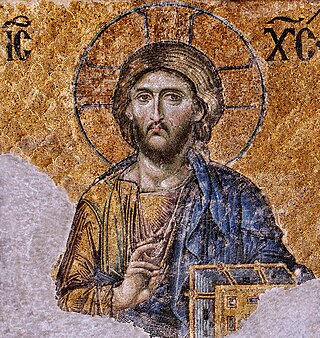
Christianity in Turkey has a long history dating back to the early origins of Christianity in Asia Minor during the 1st century AD. In modern times the percentage of Christians in Turkey has declined from 20-25% in 1914, to about 2% in 1927, to 0.2–0.4% today Sources estimate that the Christian population in Turkey ranges between 180,000 and 370,000. However, the exact number remains unclear due to the absence of a religious census in the country. The percentage of Christians in Turkey fell mainly as a result of the late Ottoman genocides: the Armenian genocide, Greek genocide, and Assyrian genocide, the population exchange between Greece and Turkey, the emigration of Christians that began in the late 19th century and gained pace in the first quarter of the 20th century, and due to events such as the 1942 Varlık Vergisi tax levied on non-Muslim citizens in Turkey and the 1955 Istanbul pogrom against Greek and Armenian Christians. Exact numbers are difficult to estimate, as many Turkish former Muslim converts to Christianity often hide their Christian faith for fear of familial pressure, religious discrimination, and persecution.

Christianity, which originated in the Middle East during the 1st century AD, is a significant minority religion within the region, characterized by the diversity of its beliefs and traditions, compared to Christianity in other parts of the Old World. Today, Christians make up approximately 5% of the Middle Eastern population, down from 13% in the early 20th century. Cyprus is the only Christian majority country in the Middle East, with Christians forming between 76% and 78% of the country's total population, most of them adhering to Eastern Orthodox Christianity. Lebanon has the second highest proportion of Christians in the Middle East, around 40%, predominantly Maronites. After Lebanon, Egypt has the next largest proportion of Christians, at around 10% of its total population. Copts, numbering around 10 million, constitute the single largest Christian community in the Middle East.

Religion in Syria refers to the range of religions practiced by the citizens of Syria. Historically, the region has been a mosaic of diverse faiths with a range of different sects within each of these religious communities.

Christians in the United Arab Emirates account for 12.9% of the total population according to 2020 estimates.
Semaan is a Christian surname mainly found in the Levant area of the Middle East. It is derived from the Semitic root word/verb sema or shema, which means “to hear”; thus, the meaning of Semaan becomes “the one who hears or listens” in both Syriac Aramaic and Arabic. Its equivalent in Hebrew is שִׁמְעוֹן, which also has the same meaning. The Greek transliteration is Σιμων (Simon) or Συμεών (Symeon), and, when Latinized, it becomes Simon or Simeon.

Eastern Orthodoxy in Syria represents Christians in Syria who are adherents of the Eastern Orthodox Church. The Eastern Orthodox tradition is represented in Syria by the Greek Orthodox Church of Antioch, the largest and oldest Christian community in the country.

The Catholic Church in the Middle East is under the spiritual leadership of the Pope in Rome. The Catholic Church is said to have traditionally originated in the Middle East in the 1st century AD, and was one of the major religions of the region from the 4th-century Byzantine reforms until the centuries following the Arab Islamic conquests of the 7th century AD. Ever since, its proportion has decreased until today's diaspora tendency, mainly due to persecution by Islamic majority societies.








